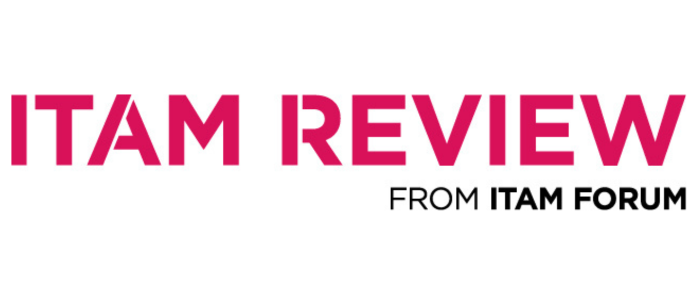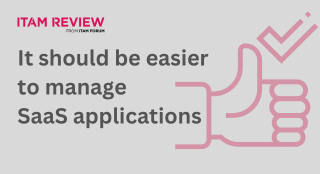SaaS Management for large organisations requires a cultural shift
In this guest article, Andréa Jacquemin, CEO & Co-founder of Beamy, discusses why SaaS management requires much more of a cultural shift for large organisations than it does for SMEs, which are generally more agile due to having fewer legacy apps and can adopt SaaS more easily.
The fate of SaaS applications over the last few years is a very profound example of how adversity can also work in your favour. Even if Software-as-a-Service (SaaS) ruled the tech space before, the pandemic really pushed it into the spotlight. The SaaS model owes its fame to its large adoption, from startups to large groups, offering new ways of working in a physically dispersed but highly connected world
However, this active purchasing of technology solutions by people at all levels in an organisation is taking away the control of IT assets from the IT department. Large groups have intricate and extensive organisational structures and a wide collaboration gap exists between the IT and other business departments. This gap, when unaddressed, gives way to exposure to data and security risks.
The biggest paradigm shift in recent years for large organisations
Businesses have gradually gained autonomy in making their own technology choices, thereby democratising the use of applications. But even though SaaS now dominates enterprise technology, it remains a “terra incognita” for the IT department. It is estimated that 30-40% of the IT budget is spent on software unknown to the IT team. This trend is exponential: by 2030, 85% of SaaS will be implemented directly by businesses.
As a response to this growing number, the IT department tries to impose strict rules to prevent security breaches. It creates cumbersome and tedious processes that hamper productivity and innovation. Employees are left with two choices: bypass the rules in order to work with the tools that fit their needs , or leave the organisation entirely to work in a more digital-native company. This is a difficulty that large organisations would gladly do without at a time when the Great Resignation is hitting them hard.
A real Cultural Revolution in large organisations
There is a common misconception that SaaS management is a unified market, but the issues and needs are completely different depending on the size of the company. SaaS is part of the DNA of small and medium-sized businesses because they are inherently more agile. In such agile SMEs, deployment and management of SaaS are not hindered by a heavy IT legacy.
Large, traditional organisations have a profound inherited legacy of a central IT ecosystem comprising of on-premise and homemade tech solutions. This ‘Core-IT’ is now facing resistance in the wake of Cloud and particularly SaaS, or the ‘Fast-IT’. Instead of resisting and sticking to what is known, large organisations have the opportunity to embrace this huge wave of SaaS to become more agile and competitive.
The challenge, therefore, is clearly to raise awareness and change attitudes. A real revolution in IT Governance is underway, and there is a balance to be struck between centralisation and decentralisation.
For the IT department, it is no longer a question of controlling everything but of giving autonomy to the business teams when possible: letting them choose their tools but also listening to and guiding them in the implementation of software in line with the company’s policies. The IT department should focus on better collaboration with other business departments, with the help of a SaaS Management Platform. This will allow CIOs to adapt to their new role and truly reinvent the collaboration between IT and business.
Allowing employees a degree of autonomy, while ensuring that they go through the appropriate processes for SaaS adoption. It is not a one-shot job and will demand continuous efforts, even if it means upsetting its initial organisation. This will allow the CIO to adapt to their new role and truly reinvent IT collaboration, as traditional tools such as SAM (Software Asset Management) are not necessarily adapted to SaaS management.
An essential for successful digital transformation
There is another misconception that SaaS management is only an IT department issue. However, it cannot be a matter for specific IT actors only, as it is a deep organisational issue that needs to be addressed at the enterprise level rather than seen as a departmental necessity.
Large organisations need to change their mindset and involve more stakeholders (DPO, procurement, security) in the SaaS management strategy as opposed to classifying it only as a “CIO issue”. The key is to frame and maintain a healthy collaboration between IT and the businesses. It will then help control the risks associated with the introduction of many external SaaS providers into the company, without restricting the freedom of employees.
SaaS management is a process much broader than what executives think, especially in large organisations. It is a process of developing a framework with defined guidelines for both the SaaS ecosystem and the stakeholders involved in an organisation. This regulatory framework, if supported by the right tool, not only minimises the risks and threats of non-compliance but also provides the company with a real-time overview of all aspects that need to be addressed. For example, the CFO (Chief Finance Officer) will always need visibility into the costs and ROI of the SaaS applications, while a CISO (Chief Information Security Officer) prioritises risk management to limit security breaches. If a CPO (Chief People Officer) uses employee empowerment as a talent retention weapon, a CEO (Chief Executive Officer) will see SaaS Management as a tool which will enable the organisation’s digital transformation.
For large organisations, this governance revolution affects all departments and represents a real challenge and opportunity for effective digital transformation. Without addressing the cultural changes that are taking place, the technology transition of large organisations will inevitably be slowed or even prevented. Therefore, the company’s management must seize this opportunity to involve all stakeholders and give the IT department the means to act quickly. A SaaS Management Platform with a model suitable for large groups is imperative to coordinate all the stakeholders, create a strong governance framework and reinvent IT & Business collaboration.
Can’t find what you’re looking for?
More from ITAM News & Analysis
-
Why ITAM Forum Should Join the Linux Foundation: My Rationale and Your Questions Answered
TLDR. ITAM Forum has the opportunity to join the Linux Foundation as a stand-alone, self-funded project. This article covers a) What’s happening b) Why I think it’s a great move for the ITAM Forum and c) ... -
Microsoft Pricing Changes: EA Customers Face Price Increases
From 1st November 2025, Microsoft will remove all tiered pricing for Online Services under the Enterprise Agreement. This means all customers renewing or purchasing new Online Services after this date, will receive standard level A pricing ... -
Shaping the Future of ITAM – We Want Your Input
The ITAM Forum is currently running a survey to capture hot topics and pressing challenges facing the ITAM profession. The insights gathered will guide our editorial focus and community content for the year ahead. Early responses ...
Software Licensing Training
Similar Posts
-
Are we ready for outcome-based pricing?
When I first joined the ITAM industry (which feels like a million years ago), the predominant licensing metric in the market was per device. So, if you have three devices, you need three licenses. Then, with ... -
It's About Time It Was Easier to Manage SaaS Applications
We’re now over a decade on from Adobe’s controversial switch to subscription (SaaS) licensing for its key products. Salesforce, the pioneers of SaaS, is in its 25th year of operation. SaaS expenditure continues to grow by ... -
Integrating SaaS Management into Traditional ITAM Frameworks
The following article was written by Matt Verlaque, COO of SaaS Academy and co-founder of High-Speed Ventures. In this article Matt provides a blueprint for secure and efficient integration of SaaS management into traditional ITAM, as ... -
ITAM & AI, FinOps, Containers, ESG, security: The many ways in which ITAM has matured beyond its roots
ITAM, AI, FinOps, Containers, ESG, security… Back in January I wrote about my picks from the agenda for Wisdom NA 2024. Building up to the event I also interviewed Eva Louis about the intricacy of IT ...





